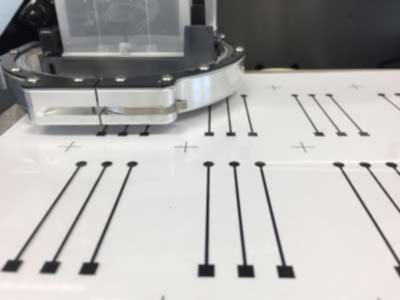The NanoEDGE BMBF-Project, coordinated by the Fraunhofer Institute for Biomedical Engineering IBMT, aims at the development of a graphene-based ink for inkjet printing and a scalable printing process as well as a resource-efficient process chain for the production of electrodes for direct skin contact.
 Printed test electrodes in the NanoEDGE project
Printed test electrodes in the NanoEDGE project
The development of a graphene-based ink is based on a commercial graphene ink. Ink modification was necessary to make it printable. Ethanol is added to avoid bubbles and to decrease the surface tension of the ink. Carbon nanoparticles are added to improve abrasion resistance of printed structures. A surfactant is added to improve printability and to increase the conductivity and surface smoothness of printed structures.
For EEG applications, further optimization of these layers, if needed, can be achieved by reducing thickness and rigidity. Such ultra-thin electrodes combined with low-cost skin electronics could form a new generation of wearable sensors.
With these sensors, the sophisticated detection of biological signals that are indicative for mental states, like neural, physiological and muscle signals, will allow for a more comprehensive portraying of mental processes, thus considerably improving mental disorder diagnosis and functional restoration.
The printing process is a two-step process: Firstly, tracks and contact pads are printed by using a silver ink. Secondly, electrodes are printed using the modified graphene ink. An inkjet printer with a 16-nozzles-printhead was used for optimization of the printing parameters. Further, suited pre- and post-processing processes and parameters were developed. In a second step, the printing process will be transferred to an inkjet system suited for mass fabrication.
The wearable electronics in this project are based on the BIOPOT of SensoMedical Labs LTD. The BIOPOT is a wireless bioimpedance and biopotential amplifier with a data transmission and data acquisition device that is used as a platform for product development in neurotechnology. It is a small size and low-profile wearable with a customizable form factor that allows for days of activity monitoring. It uses Bluetooth low-energy 5.0 technology for data transmission and has on-board data buffer. It is also designed as a patch device for data acquisition. It is available in 8 or 19 channels options and can be configured for either EEG, EMG or other biopotential readings.
The interdisciplinary approach of the NanoEDGE research project aims to converge the production techniques for functionalized electrodes with expertise in nanomaterial fabrication and characterization, state-of-the-art engineering, and neuroscience. Thus will improve the production of multi-level sensors and enhance the performance of monitoring methods like EEG and EMG. State-of-the-art skin electronics will be enhanced by combining the printed electrodes with advanced electronics design of wearable electronics and wireless signal transmission.
NanoEDGE will develop resource-efficient production technologies and scalable processes for small scale and high-throughput electrode manufacturing and functionalization. To this end, laboratory scale processes for fabrication and functionalization of carbon nanomaterial-based electrodes available within the project consortium will be combined with the expertise in development of inkjet printers and inkjet printing technology. This combination of expertise will lead to new production processes and process chains and simplify usability and decrease costs.
Specifically, the project will target the testing of the novel and low-cost skin electronics technology for EEG based neurofeedback systems towards implementation in mental disorder diagnosis and mental function restoration.
NanoEDGE is a joint R&D project comprising participants from Germany and Israel.